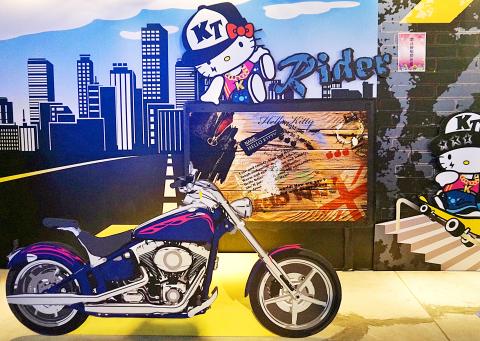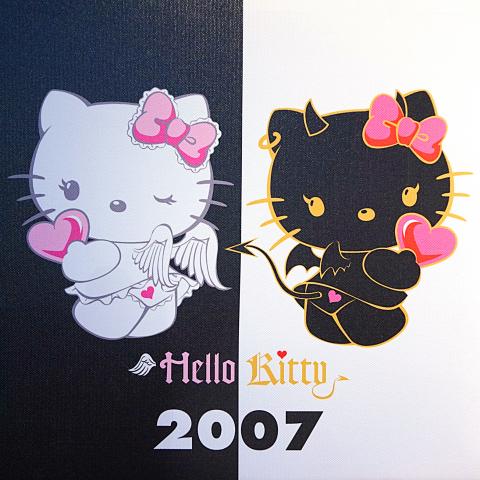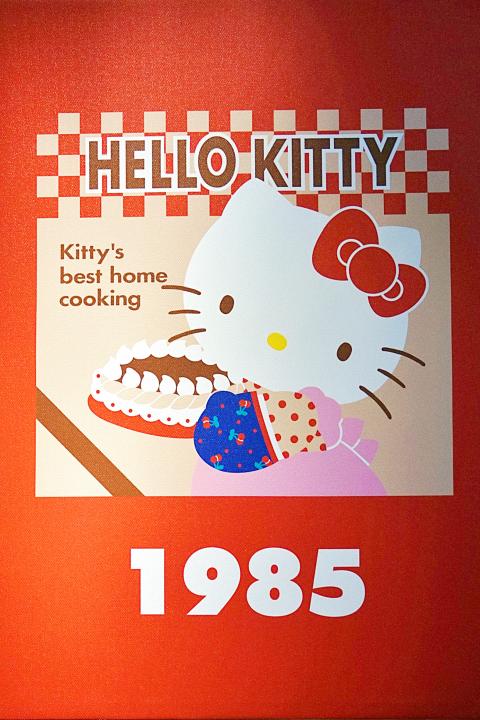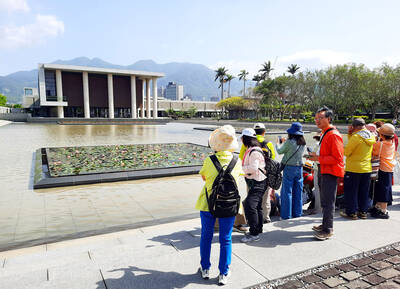There are certain levels of Hello Kitty cuteness that one can tolerate. Hello Kitty-themed cafes, hotel rooms, and airplanes, for example, have the effect of making one smile. Others, such as maternity wards, probably raise eyebrows. But love it or hate it, Hello Kitty is a way of life.
Although it is recognized first and foremost as being synonymous with kawaii culture, there is also a dark side to this adorable cat. The fact that Hello Kitty’s face is plastered on beer cans, dildos and even condom wrappers shows how deeply (and somewhat disturbingly) ingrained this culture of cute is in Taiwan.
Nowadays, Hello Kitty is not simply child’s play — it serves to titillate grown-ups as well.

Photo: Dana Ter
For those seeking to learn more about the phenomenon, Taipei’s Songshan Cultural and Creative Park (松山文創園區) is hosting a two-and-a-half-month long Hello Kitty 40th Anniversary Exhibition. Regular tickets are set at NT$280 but those wanting to watch the hologram show in addition to the exhibition will have to pay NT$560.
Running until Sept. 14, the exhibition showcases Hello Kitty toys in various bizarrely-themed rooms from discos to skateboarding rings. Most of the displays ooze cuteness, but there are hints of sexy and naughty in certain ones as well.
STIFF AS A BOARD

Photo: Dana Ter
Although the tickets are overpriced for an exhibition that has nothing extraordinary to boast about, visitors last weekend did not seem to mind. Most were die-hard fans, as many of the women and children came dressed in Hello Kitty shirts and costumes. Relying merely on Taiwan’s huge Hello Kitty fan base to attract visitors, the exhibition’s layout and design clearly lacked imagination.
The hologram show in particular was utterly disappointing — watching a life-sized Hello Kitty hologram bopping and twirling to high-pitch background music singing “kitty, kitty, kitty” is simply not worth the extra NT$280. Moreover, the gift store selling Hello Kitty t-shirts, flip flops, cups and notebooks in the last room was a typical run-of-the-mill advertising gimmick — one that might have been spiced up by a dildo section.
Each room in the main exhibition hall was designed in such a way as to encourage picture-taking, and visitors last weekend were mainly interested in doing just that. The “Hello Kitty Town” which essentially consisted of a few cardboard cutouts with words such as “cafe,” “deco shop” and “fashion and design” slapped on them, served as backdrops for visitors to pose for pictures. The make-believe town also included a Hello Kitty ticket booth, train station and New York City-style subway. Like the hologram show though, the displays were stiff and one-dimensional.

Photo: Dana Ter
MANY FACES
Where the exhibition lacked in design creativity, it made up in explaining the history and cultural significance of the cartoon. The wall of Hello Kitty comics dating from 1974 to today especially illustrated how cultural values and social norms have evolved over time. Earlier drawings from the 1970s and 1980s tended to depict Hello Kitty in domestic settings like showing her cooking in a kitchen. By contrast, comics after the year 2000 portrayed her as taking on more raunchy personas. In the 2007 poster, for instance, there are two Hello Kitties in a devil and angel costume and both are striking cheeky poses.
Other rooms featured life-size Hello Kitty toys dancing at discos and trekking through jungles filled with rainbow-colored apples. In contrast to the cute, pink motif seen throughout “Hello Kitty Town,” the skateboarding room in particular revealed a different side to the cartoon. Apparently, everyone’s favorite cat not only enjoys high tea, but she also rides motorcycles and skateboards.
Those less obsessed with the cartoon may wonder why Hello Kitty is riding a motorcycle. The answer is simple: why not? Oddly enough, the one thing that the exhibition does well is portraying Hello Kitty as an empowered feminist. From DJ Kitty to skateboarding Kitty, the displays make clear that gone are the days where Hello Kitty’s sole duties were in the kitchen.
Hello Kitty might have started out as primarily appealing to young girls, but as the exhibition demonstrates, it now resonates with the public at large. Regardless of overpriced tickets and trite advertising gimmicks, it provides a portal into understanding Taiwan’s obsession with Hello Kitty and the many subtexts associated with “cuteness.”

When the South Vietnamese capital of Saigon fell to the North Vietnamese forces 50 years ago this week, it prompted a mass exodus of some 2 million people — hundreds of thousands fleeing perilously on small boats across open water to escape the communist regime. Many ultimately settled in Southern California’s Orange County in an area now known as “Little Saigon,” not far from Marine Corps Base Camp Pendleton, where the first refugees were airlifted upon reaching the US. The diaspora now also has significant populations in Virginia, Texas and Washington state, as well as in countries including France and Australia.

On April 17, Chinese Nationalist Party (KMT) Chairman Eric Chu (朱立倫) launched a bold campaign to revive and revitalize the KMT base by calling for an impromptu rally at the Taipei prosecutor’s offices to protest recent arrests of KMT recall campaigners over allegations of forgery and fraud involving signatures of dead voters. The protest had no time to apply for permits and was illegal, but that played into the sense of opposition grievance at alleged weaponization of the judiciary by the Democratic Progressive Party (DPP) to “annihilate” the opposition parties. Blamed for faltering recall campaigns and faced with a KMT chair

Article 2 of the Additional Articles of the Constitution of the Republic of China (中華民國憲法增修條文) stipulates that upon a vote of no confidence in the premier, the president can dissolve the legislature within 10 days. If the legislature is dissolved, a new legislative election must be held within 60 days, and the legislators’ terms will then be reckoned from that election. Two weeks ago Taipei Mayor Chiang Wan-an (蔣萬安) of the Chinese Nationalist Party (KMT) proposed that the legislature hold a vote of no confidence in the premier and dare the president to dissolve the legislature. The legislature is currently controlled

Dull functional structures dominate Taiwan’s cityscapes. But that’s slowly changing, thanks to talented architects and patrons with deep pockets. Since the start of the 21st century, the country has gained several alluring landmark buildings, including the two described below. NUNG CHAN MONASTERY Dharma Drum Mountain (法鼓山, DDM) is one of Taiwan’s most prominent religious organizations. Under the leadership of Buddhist Master Sheng Yen (聖嚴), who died in 2009, it developed into an international Buddhist foundation active in the spiritual, cultural and educational spheres. Since 2005, DDM’s principal base has been its sprawling hillside complex in New Taipei City’s Jinshan District (金山). But